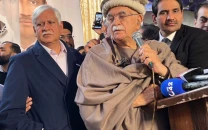The march of devolution
The cast of characters in the provincial capitals is as varied as the nation they represent

if the provincial budgets for fiscal year 2016 are anything to go by, the people of Pakistan have a wide variety of political options to choose from when we next go to the polls in 2018. CREATIVE COMMONS

Let us start with Khyber-Pakhtunkhwa (K-P), where the PTI has made no secret of its desire to use the platform afforded to it by the voters in that province to prove its worthiness in governance. Even its most strident critics — and this newspaper has been one of them in the past — must admit that when it comes to its most important political rhetoric, the PTI has been true to its word. Before the 2013 election, the party promised an elected local government system in the provinces it would govern. It has taken the PTI some time (a little too long, in our opinion), but it has not only managed to have a local government election — admittedly flawed, but nevertheless a step in the right direction — but also, through the K-P budget for fiscal year 2016, granted those local governments with real financial autonomy. This is the logical next step from the 18th Amendment and the 7th National Finance Commission Award, which brought power down from Islamabad to the provinces. K-P has taken the next step to take power even closer to the people and we hope this trend catches on among other parts of the country.
Meanwhile, in Punjab, the PML-N government will spend well over a quarter of its money on educating the children of the province and a significant chunk on improving its energy and transportation infrastructure. Punjab has its fair share of problems, and Chief Minister Shahbaz Sharif’s management style leaves much to be desired, but there is nothing wrong with that order of priorities. The one critique we continue to have about the Punjab budget is the regional disparities within the province: far too much money is spent on Lahore and not nearly enough on other parts of the provinces, especially the southern parts. Need we remind the PML-N, winning Lahore alone will not win it Punjab. And without the near-unanimous support of Punjab, its electoral chances in 2018 will look slim.
Speaking of formerly national parties that have shrivelled to a shadow of their former selves, the PPP in Sindh appears to be in no mood to begin governing the province that has elected Qaim Ali Shah chief minister three times. Sindh has the dubious distinction of being the only province in the entire country that will actually reduce its development budget and will spend measly sums on education, health and infrastructure. Meanwhile, the political gravy train, known as the discretionary development spending allocations for legislators, continues to grow. While former president Asif Ali Zardari may be trying to revive the passions of his party members with fiery speeches about democracy, he might want to start with a lecture on governance to his provincial cabinet.
The Balochistan government, for its part, is one that is technically allied with the current ruling party in Islamabad, but nonetheless offers an interesting insight into the politics of the smallest province. For one thing, it is the only province whose budget speech was not delivered by a cabinet member, but rather by an executive-appointed adviser. And after two years of promising talk, it appears that Chief Minister Abdul Malik Baloch’s government is out of good ideas and just wants to make life comfortable for bureaucrats and politicians in Quetta, or at least that is what it looks like judging from the number of parks, sanitation and power projects focused on the provincial capital.
In short, the cast of characters in the provincial capitals is as varied as the nation they represent. Each of these parties vies for higher office and each will be judged by the voters on its performance. Based on the budgets offered, many of them have a lot of work to do.
Published in The Express Tribune, June 19th, 2015.
Like Opinion & Editorial on Facebook, follow @ETOpEd on Twitter to receive all updates on all our daily pieces.














COMMENTS
Comments are moderated and generally will be posted if they are on-topic and not abusive.
For more information, please see our Comments FAQ